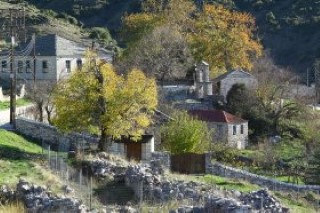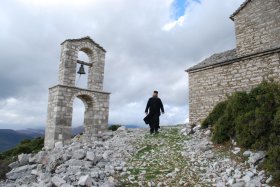At a distance of 18 km away from Konitsa, on the southern slopes of the peak Tsouka-Koula (altitude 1529 m) and at an altitude of 880 m, lies the old settlement of Kleidonia. Today the settlement is officially referred to as Ano Kleidonia, while a century ago it was called “Litouniavista” or “Kleidoniavista”.
The view from Ano Klidonia is impressive! The eye of the visitor “meets” the composition of a beautiful landscape: at the background lies the plain of Konitsa and the surrounding villages lie at the junction of the two great rivers, Aoos and Voidomatis.
In the village, some old stone houses are preserved, several churches as well and a little further there is a part of an old monastery.
Ano Kleidonia is known for its post-Byzantine monuments. At the entrance of the village, next to the main road and on the path that leads to the new village and in an obvious place with unrestricted views to the plain, is the church of Agios Athanasios (built in 1617). It is a cross-roofed single-aisled church, which is decorated with stunning art paintings.
The parish church of the village (dedicated to the Assumption of the Virgin) is located in the center of the settlement and dates from the 17th century. A little further, on a hill to the southeast, is the church of Agios Nikolaos. It was built in 1620 in a special way with small hewn stones at the base of the masonry. Also, there are smaller temples in Ano Kleidonia: Prophet Elias is on the path to the neighboring village Papigo and Agia Paraskevi is at the northern end of the settlement.
The Monastery of Agioi Apostoloi, which is located in the southeast of the village (in a 15-minute walk) dates back to 1662. Its single-aisled basilica has remarkable hagiographies and it is a historic monument. The incomparable portable art icons of all the temples of Ano Kleidonia have been transferred elsewhere for safety reasons.
In the village, there is a guest house that also offers food. Remarkable paths lead upwards to the top of Koula, to the neighboring village of Zagori, Papigo and downwards, towards the plain, to the modern settlement of Kleidonia.













